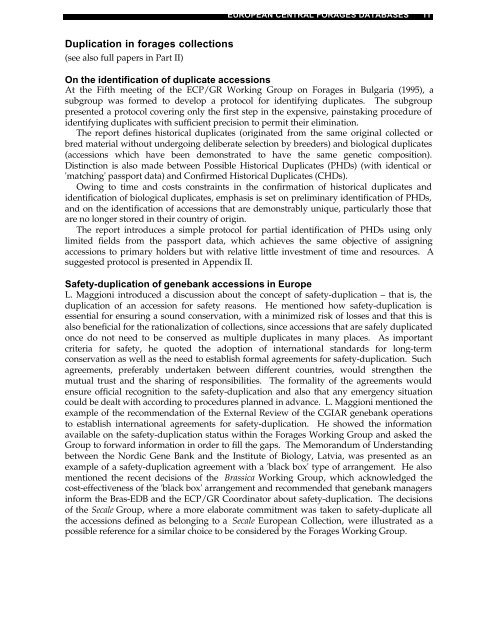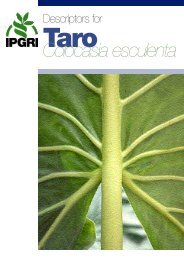Download PDF (6215 kb) - Bioversity International
Download PDF (6215 kb) - Bioversity International
Download PDF (6215 kb) - Bioversity International
Create successful ePaper yourself
Turn your PDF publications into a flip-book with our unique Google optimized e-Paper software.
Duplication in forages collections<br />
(see also full papers in Part II)<br />
EUROPEAN CENTRAL FORAGES DATABASES 11<br />
On the identification of duplicate accessions<br />
At the Fifth meeting of the ECP/GR Working Group on Forages in Bulgaria (1995), a<br />
subgroup was formed to develop a protocol for identifying duplicates. The subgroup<br />
presented a protocol covering only the first step in the expensive, painstaking procedure of<br />
identifying duplicates with sufficient precision to permit their elimination.<br />
The report defines historical duplicates (originated from the same original collected or<br />
bred material without undergoing deliberate selection by breeders) and biological duplicates<br />
(accessions which have been demonstrated to have the same genetic composition).<br />
Distinction is also made between Possible Historical Duplicates (PHDs) (with identical or<br />
'matching' passport data) and Confirmed Historical Duplicates (CHDs).<br />
Owing to time and costs constraints in the confirmation of historical duplicates and<br />
identification of biological duplicates, emphasis is set on preliminary identification of PHDs,<br />
and on the identification of accessions that are demonstrably unique, particularly those that<br />
are no longer stored in their country of origin.<br />
The report introduces a simple protocol for partial identification of PHDs using only<br />
limited fields from the passport data, which achieves the same objective of assigning<br />
accessions to primary holders but with relative little investment of time and resources. A<br />
suggested protocol is presented in Appendix II.<br />
Safety-duplication of genebank accessions in Europe<br />
L. Maggioni introduced a discussion about the concept of safety-duplication – that is, the<br />
duplication of an accession for safety reasons. He mentioned how safety-duplication is<br />
essential for ensuring a sound conservation, with a minimized risk of losses and that this is<br />
also beneficial for the rationalization of collections, since accessions that are safely duplicated<br />
once do not need to be conserved as multiple duplicates in many places. As important<br />
criteria for safety, he quoted the adoption of international standards for long-term<br />
conservation as well as the need to establish formal agreements for safety-duplication. Such<br />
agreements, preferably undertaken between different countries, would strengthen the<br />
mutual trust and the sharing of responsibilities. The formality of the agreements would<br />
ensure official recognition to the safety-duplication and also that any emergency situation<br />
could be dealt with according to procedures planned in advance. L. Maggioni mentioned the<br />
example of the recommendation of the External Review of the CGIAR genebank operations<br />
to establish international agreements for safety-duplication. He showed the information<br />
available on the safety-duplication status within the Forages Working Group and asked the<br />
Group to forward information in order to fill the gaps. The Memorandum of Understanding<br />
between the Nordic Gene Bank and the Institute of Biology, Latvia, was presented as an<br />
example of a safety-duplication agreement with a 'black box' type of arrangement. He also<br />
mentioned the recent decisions of the Brassica Working Group, which acknowledged the<br />
cost-effectiveness of the 'black box' arrangement and recommended that genebank managers<br />
inform the Bras-EDB and the ECP/GR Coordinator about safety-duplication. The decisions<br />
of the Secale Group, where a more elaborate commitment was taken to safety-duplicate all<br />
the accessions defined as belonging to a Secale European Collection, were illustrated as a<br />
possible reference for a similar choice to be considered by the Forages Working Group.




